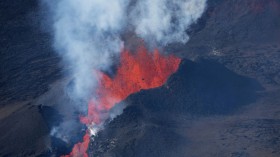El Niño winter is coming and meteorologists confirm that the warm climate pattern's impact in the Northern Hemisphere, including the United States, could be felt ahead of the upcoming 2023 winter season. The said phenomenon may alter weather conditions in the coming months, particularly starting December 2023. Some of the potential winter weather hazards include rainfall and warmer temperatures. Yet, harsh winter storms like the ones last year are still possible.
The US is heading to its 'projected' warmer-than-usual winter later this year. However, the effects of the warm climate phenomenon remain hardly felt for now, as the current Atlantic hurricane season remains busy. This is in addition to the recent and ongoing severe thunderstorms in different parts of the country. Yet, a forecast by the National Oceanic and Atmospheric Administration (NOAA) indicates the El Niño winter has a 95% chance of persisting during the approaching winter.
El Niño Winter

In its updated forecast, the NOAA through its Climate Prediction Center (CPC) on September 14 stated that El Niño is expected to continue during the Northern Hemisphere winter, with a chance greater than 95% from January 2024 to March 2024. This projection is based on above-average sea surface temperatures back in August 2023 across the equatorial Pacific Ocean, as well as in the central and east-central Pacific.
According to the CPC, the most recent data shows El Niño will persist during the 2023-2024 winter season in the Northern Hemisphere, despite having almost the same 'ensemble mean amplitude' last month. Furthermore, the NOAA winter forecast says the impacts of at least a strong El Niño can be felt as early as November.
Also Read: Australia Forecast: El Nino Likely to Cause Hot, Dry Weather
El Niño Arrival
In June 2023, the NOAA declared the arrival of El Niño, with forecasters issuing "El Nino Advisory" which shows that "El Nino conditions" have emerged and are anticipated to gradually intensify into the winter season, as cited by the National Weather Service (NWS).
According to the NWS, El Niño (sometimes spelled as El Nino), is a natural climate phenomenon known for its warmer-than-average sea surface temperatures in the Central Pacific and Eastern Pacific Ocean, near the equator. This phenomenon occurs every 2 to 7 years on average, with impacts extending far beyond the Pacific.
Is El Niño a Disaster?
In the past, El Niño has driven the occurrence of extreme weather events in different parts of the world, causing catastrophic natural disasters.
El Niño can cause severe drought in Australia, Indonesia, and South Asia, as well as Central America and northern parts of South America, according to the International Federation of Red Cross and Red Crescent Societies (IFRC).
Back in July 2023, the World Meteorological Organization (WMO) announced that El Niño conditions have developed, warning that it can cause disruptive weather and climate patterns and global temperature rise.
Related Article: El Nino to Bring Warmer Temperatures After Official End of La Nina
© 2024 NatureWorldNews.com All rights reserved. Do not reproduce without permission.





